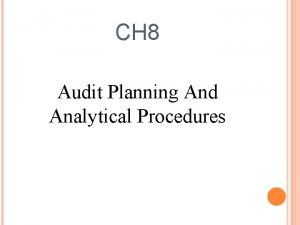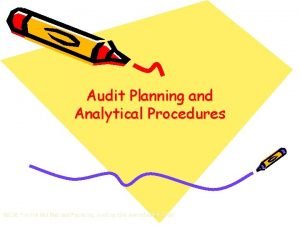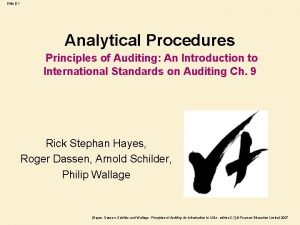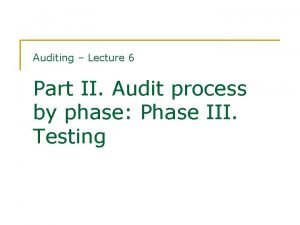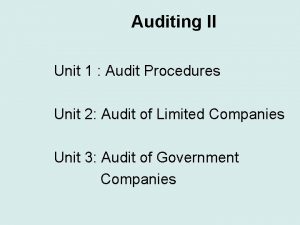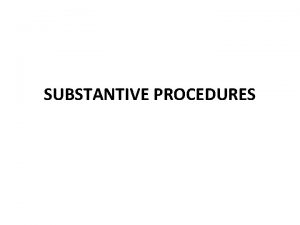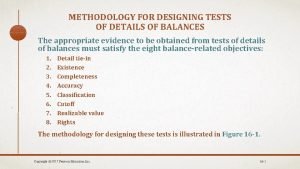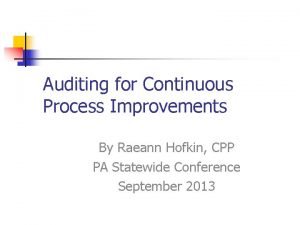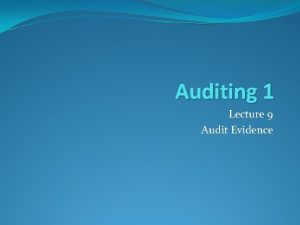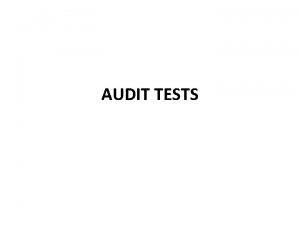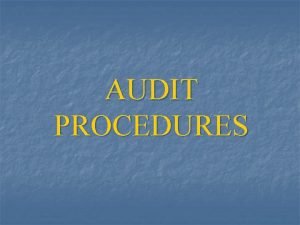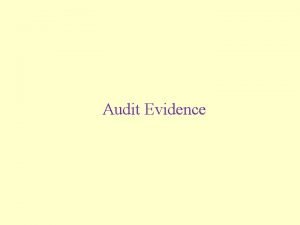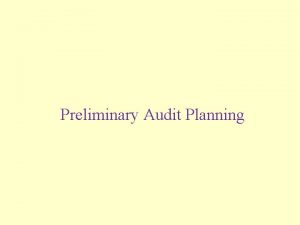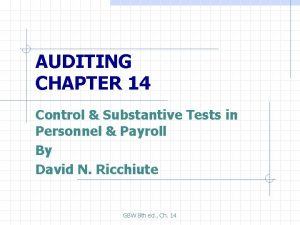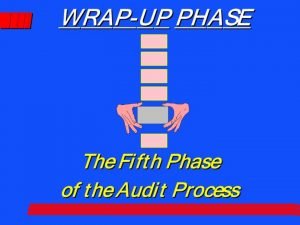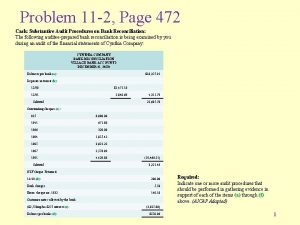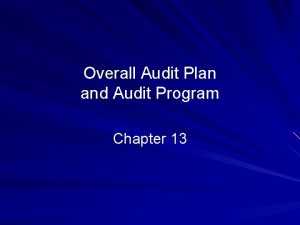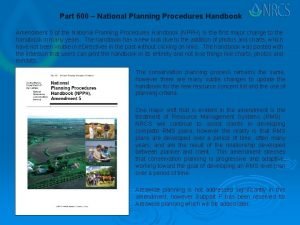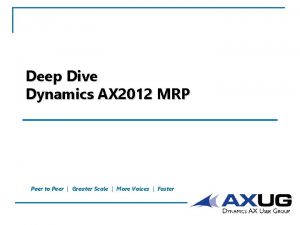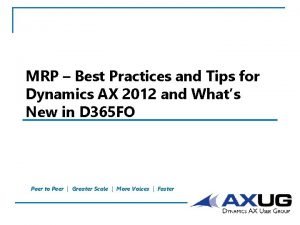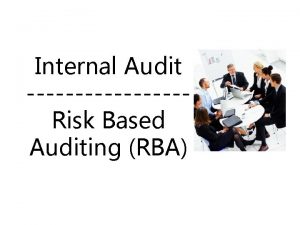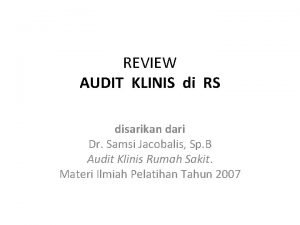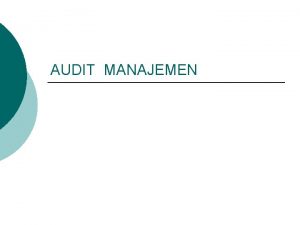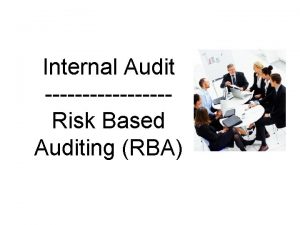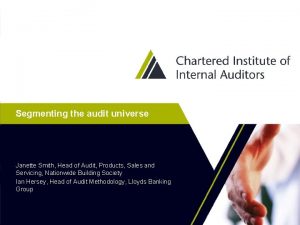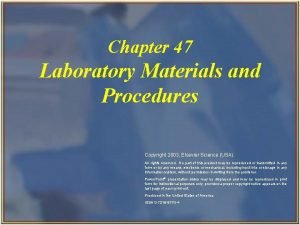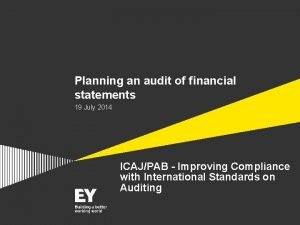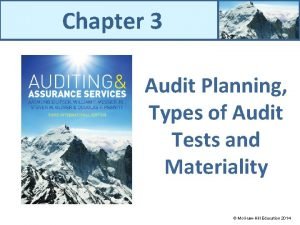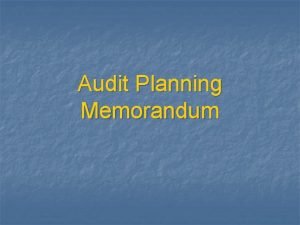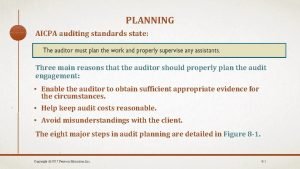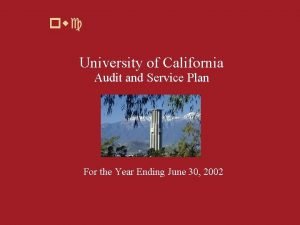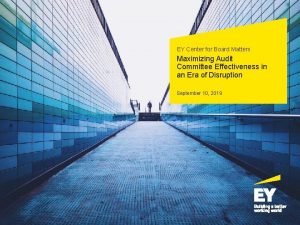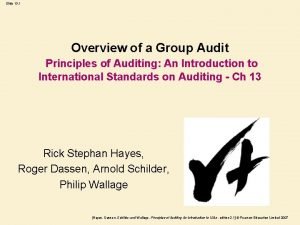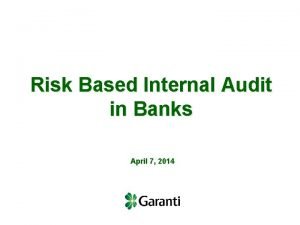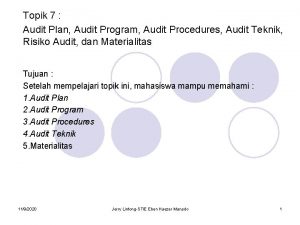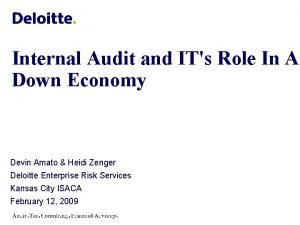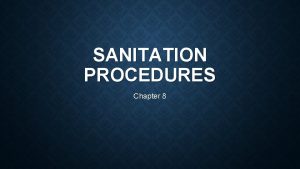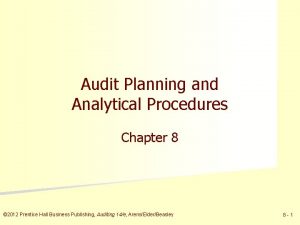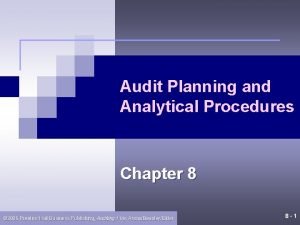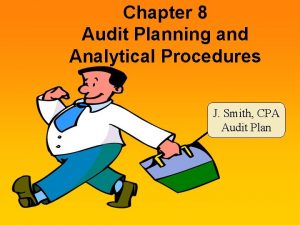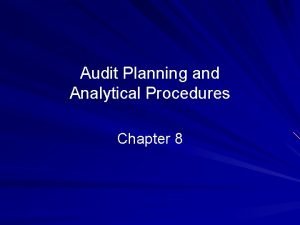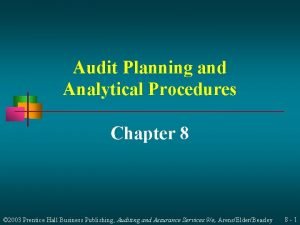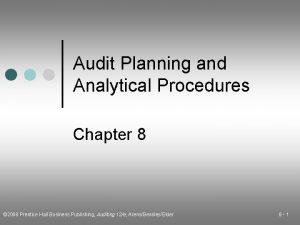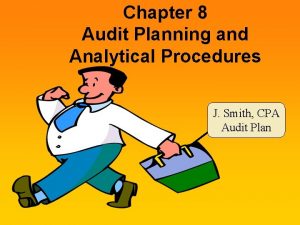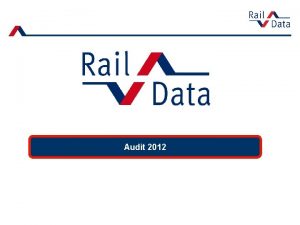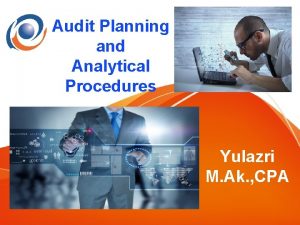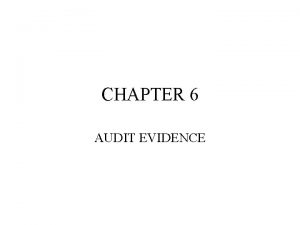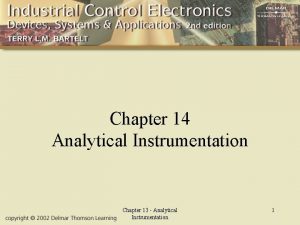Audit Planning and Analytical Procedures Chapter 8 2012
















































- Slides: 48

Audit Planning and Analytical Procedures Chapter 8 © 2012 Prentice Hall Business Publishing, Auditing 14/e, Arens/Elder/Beasley 8 -1

Learning Objective 1 Discuss why adequate audit planning is essential. © 2012 Prentice Hall Business Publishing, Auditing 14/e, Arens/Elder/Beasley 8 -2

Three Main Reasons for Planning 1. To obtain sufficient appropriate evidence for the circumstances 2. To help keep audit costs reasonable 3. To avoid misunderstanding with the client © 2012 Prentice Hall Business Publishing, Auditing 14/e, Arens/Elder/Beasley 8 -3

Three Main Reasons for Planning © 2012 Prentice Hall Business Publishing, Auditing 14/e, Arens/Elder/Beasley 8 -4

Risk Terms Ø Acceptable audit risk Ø Inherent risk © 2012 Prentice Hall Business Publishing, Auditing 14/e, Arens/Elder/Beasley 8 -5

Learning Objective 2 Make client acceptance decisions and perform initial audit planning. © 2012 Prentice Hall Business Publishing, Auditing 14/e, Arens/Elder/Beasley 8 -6

Initial Audit Planning 1. Client acceptance and continuance 2. Identify client’s reasons for audit 3. Obtain an understanding with the client 4. Develop overall audit strategy © 2012 Prentice Hall Business Publishing, Auditing 14/e, Arens/Elder/Beasley 8 -7

Client Acceptance and Continuance ØNew client investigations §If previously audited, the new auditor is required to communicate with the predecessor auditor §Client permission required ØContinuing clients §Annual evaluations whether to continue based on issues, fees, and client integrity © 2012 Prentice Hall Business Publishing, Auditing 14/e, Arens/Elder/Beasley 8 -8

Identify Reasons for the Audit ØTwo major factors affecting acceptable risk §Likely statement users §Intended uses of the statements ØLikely to accumulate more evidence for companies that are §Publicly held §Have extreme indebtedness §Likely to be sold © 2012 Prentice Hall Business Publishing, Auditing 14/e, Arens/Elder/Beasley 8 -9

Obtaining an Understanding with the Client ØEngagement terms should be understood between CPA and client. ØStandards require an engagement letter describing: §objectives §responsibilities of auditor and management §schedules and fees ØInforms client that auditor cannot guarantee all acts of fraud will be discovered ØSee figure 8 -2 © 2012 Prentice Hall Business Publishing, Auditing 14/e, Arens/Elder/Beasley 8 - 10

Develop Overall Audit Strategy ØPreliminary audit strategy should consider §client’s business and industry §material misstatement risk areas §number of client locations §past effectiveness of controls ØPreliminary strategy helps auditor determine resource requirements and staffing §staff continuity §need for specialists © 2012 Prentice Hall Business Publishing, Auditing 14/e, Arens/Elder/Beasley 8 - 11

Learning Objective 3 Gain an understanding of the client’s business and industry. © 2012 Prentice Hall Business Publishing, Auditing 14/e, Arens/Elder/Beasley 8 - 12

Understanding of the Client’s Business and Industry Client business risk is the risk that the client will fail to meet its objectives. Ø Information technology ØGlobal operations ØHuman capital © 2012 Prentice Hall Business Publishing, Auditing 14/e, Arens/Elder/Beasley 8 - 13

Understanding of the Client’s Business and Industry © 2012 Prentice Hall Business Publishing, Auditing 14/e, Arens/Elder/Beasley 8 - 14

Industry and External Environment Reasons for obtaining an understanding of the client’s industry and external environment: 1. Risks associated with specific industries 2. Inherent risks common to all clients in certain industries 3. Unique accounting requirements © 2012 Prentice Hall Business Publishing, Auditing 14/e, Arens/Elder/Beasley 8 - 15

Business Operations and Processes Factors the auditor should understand: Ø Ø Major sources of revenue Key customers and suppliers Sources of financing Information about related parties © 2012 Prentice Hall Business Publishing, Auditing 14/e, Arens/Elder/Beasley 8 - 16

Tour the Plant and Offices Touring the physical facilities enables the auditor to assess asset safeguards and interpret accounting data related to assets. © 2012 Prentice Hall Business Publishing, Auditing 14/e, Arens/Elder/Beasley 8 - 17

Identify Related Parties ØAffiliated companies ØPrincipal owners of the client ØAny other party with which the client deals ØA party who can influence management or client policies © 2012 Prentice Hall Business Publishing, Auditing 14/e, Arens/Elder/Beasley 8 - 18

Management and Governance includes: ØOrganizational structure ØBoard activities ØAudit committee activities. Governance insights: ØCorporate charter and bylaws ØCode of ethics ØMeeting minutes Management establishes the strategies and processes followed by the client’s business. © 2012 Prentice Hall Business Publishing, Auditing 14/e, Arens/Elder/Beasley 8 - 19

Code of Ethics In response to the Sarbanes-Oxley Act, the SEC now requires each public company to disclose whether is has adopted a code of ethics that applies to senior management. The SEC also requires companies to disclose amendments and waivers to the code of ethics. © 2012 Prentice Hall Business Publishing, Auditing 14/e, Arens/Elder/Beasley 8 - 20

Client Objectives and Strategies are approaches followed by the entity to achieve organizational objectives. Auditors should understand client objectives. ØFinancial reporting reliability ØEffectiveness and efficiency of operations ØCompliance with laws and regulations © 2012 Prentice Hall Business Publishing, Auditing 14/e, Arens/Elder/Beasley 8 - 21

Measurement and Performance The client’s performance measurement system includes key performance indicators. Examples: Ø market share Ø sales per employee Ø unit sales growth Ø Web site visitors Ø same-store sales Ø sales/square foot Performance measurement includes ratio analysis and benchmarking against key competitors. © 2012 Prentice Hall Business Publishing, Auditing 14/e, Arens/Elder/Beasley 8 - 22

Learning Objective 4 Assess client business risk. © 2012 Prentice Hall Business Publishing, Auditing 14/e, Arens/Elder/Beasley 8 - 23

Assess Client Business Risk Client business risk is the risk that the client will fail to achieve its objectives. Ø What is the auditor’s primary concern? Ø Material misstatements in the financial statements due to client business risk © 2012 Prentice Hall Business Publishing, Auditing 14/e, Arens/Elder/Beasley 8 - 24

Client’s Business, Risk, and Risk of Material Misstatement © 2012 Prentice Hall Business Publishing, Auditing 14/e, Arens/Elder/Beasley 8 - 25

Sarbanes-Oxley Act Management must certify it has designed disclosure controls and procedures to ensure that material information about business risks is made known to them. Management must certify it has informed the auditor and audit committee of any significant control deficiencies. © 2012 Prentice Hall Business Publishing, Auditing 14/e, Arens/Elder/Beasley 8 - 26

Learning Objective 5 Perform preliminary analytical procedures. © 2012 Prentice Hall Business Publishing, Auditing 14/e, Arens/Elder/Beasley 8 - 27

Preliminary Analytical Procedures Comparison of client ratios to industry or competitor benchmarks provides an indication of the company’s performance. Preliminary tests can reveal unusual changes in ratios. © 2012 Prentice Hall Business Publishing, Auditing 14/e, Arens/Elder/Beasley 8 - 28

Examples of Planning Analytical Procedures © 2012 Prentice Hall Business Publishing, Auditing 14/e, Arens/Elder/Beasley 8 - 29

Summary of the Parts of Auditing Planning A major purpose is to gain an understanding of the client’s business and industry. © 2012 Prentice Hall Business Publishing, Auditing 14/e, Arens/Elder/Beasley 8 - 30

Planning an Audit and Designing an Audit Approach ØSet materiality and assess acceptable audit risk and inherent risk. ØUnderstand internal control and assess control risk ØGather information to assess fraud risks ØDevelop overall audit plan and audit program © 2012 Prentice Hall Business Publishing, Auditing 14/e, Arens/Elder/Beasley 8 - 31

Learning Objective 6 State the purposes of analytical procedures and the timing of each procedure. © 2012 Prentice Hall Business Publishing, Auditing 14/e, Arens/Elder/Beasley 8 - 32

Analytical Procedures AU 329 emphasizes the expectations developed by the auditor. 1. Required in the planning phase 2. Often done during the testing phase 3. Required during the completion phase © 2012 Prentice Hall Business Publishing, Auditing 14/e, Arens/Elder/Beasley 8 - 33

Timing and Purposes of Analytical Procedures © 2012 Prentice Hall Business Publishing, Auditing 14/e, Arens/Elder/Beasley 8 - 34

Learning Objective 7 Select the most appropriate analytical procedure from among the five major types. © 2012 Prentice Hall Business Publishing, Auditing 14/e, Arens/Elder/Beasley 8 - 35

Five Types of Analytical Procedures Compare client data with: 1. Industry data 2. Similar prior-period data 3. Client-determined expected results 4. Auditor-determined expected results 5. Expected results using nonfinancial data. © 2012 Prentice Hall Business Publishing, Auditing 14/e, Arens/Elder/Beasley 8 - 36

Compare Client and Industry Data Client 2009 Inventory turnover 3. 4 Gross margin 26. 3% Industry 2008 2009 2008 3. 5 26. 4% 3. 9 27. 3% 3. 4 26. 2% © 2012 Prentice Hall Business Publishing, Auditing 14/e, Arens/Elder/Beasley 8 - 37

Internal Comparisons © 2012 Prentice Hall Business Publishing, Auditing 14/e, Arens/Elder/Beasley 8 - 38

Compare Client Data with Similar Prior Period Data 2009 (000) % of Prelim. Net sales Cost of goods sold Gross profit Selling expense Administrative expense Other Earnings before taxes Income taxes Net income $143, 086 103, 241 $ 39, 845 14, 810 17, 665 1, 689 $ 5, 681 1, 747 $ 3, 934 © 2012 Prentice Hall Business Publishing, Auditing 14/e, Arens/Elder/Beasley 100. 0 72. 1 27. 9 10. 3 12. 4 1. 2 4. 0 1. 2 2. 8 2008 (000) % of Prelim. Net sales $131, 226 100. 0 94, 876 72. 3 $ 36, 350 27. 7 12, 899 9. 8 16, 757 12. 8 2, 035 1. 6 $ 4, 659 3. 5 1, 465 1. 1 $ 3, 194 2. 4 8 - 39

Learning Objective 8 Compute common financial ratios. © 2012 Prentice Hall Business Publishing, Auditing 14/e, Arens/Elder/Beasley 8 - 40

Common Financial Ratios Ø Short-term debt-paying ability ØLiquidity activity ratios ØAbility to meet long-term debt obligations ØProfitability ratios © 2012 Prentice Hall Business Publishing, Auditing 14/e, Arens/Elder/Beasley 8 - 41

Short-term Debt-paying Ability Cash ratio (Cash + Marketable securities) = Current liabilities Quick ratio (Cash + Marketable securities = + Net accounts receivable) Current liabilities Current assets Current ratio = Current liabilities © 2012 Prentice Hall Business Publishing, Auditing 14/e, Arens/Elder/Beasley 8 - 42

Liquidity Activity Ratios Accounts receivable Net sales = turnover Average gross receivables Days to collect receivable 365 days = Accounts receivable turnover Inventory turnover Cost of goods sold = Average inventory Days to sell inventory 365 days = Inventory turnover © 2012 Prentice Hall Business Publishing, Auditing 14/e, Arens/Elder/Beasley 8 - 43

Ability to Meet Long-term Debt Obligation Debt to equity = Total liabilities Total equity Times interest Operating income = earned Interest expense © 2012 Prentice Hall Business Publishing, Auditing 14/e, Arens/Elder/Beasley 8 - 44

Profitability Ratios Earnings per share = Gross profit = percent Profit margin Net income Average common shares outstanding (Net sales – Cost of goods sold) Net sales Operating income = Net sales © 2012 Prentice Hall Business Publishing, Auditing 14/e, Arens/Elder/Beasley 8 - 45

Profitability Ratios Return on = assets Income before taxes Average total assets Return on common = equity (Income before taxes – Preferred dividends) Average stockholders’ equity © 2012 Prentice Hall Business Publishing, Auditing 14/e, Arens/Elder/Beasley 8 - 46

Summary of Analytical Procedures Compare ratios of recorded amounts to auditor expectations. Used in planning to understand client’s business and industry. Used throughout the audit Øto identify possible misstatements Øreduce detailed tests Øassess going-concern issues. © 2012 Prentice Hall Business Publishing, Auditing 14/e, Arens/Elder/Beasley 8 - 47

End of Chapter 8 © 2012 Prentice Hall Business Publishing, Auditing 14/e, Arens/Elder/Beasley 8 - 48
 Audit planning and analytical procedures
Audit planning and analytical procedures Audit planning and analytical procedures
Audit planning and analytical procedures Types of analytical procedures
Types of analytical procedures Analytical procedures examples
Analytical procedures examples Analytical procedures examples
Analytical procedures examples What are substantive procedures in auditing
What are substantive procedures in auditing Test of detail
Test of detail Raeann hofkin
Raeann hofkin Audit procedures
Audit procedures Substantive procedures audit
Substantive procedures audit Substantive procedures in audit
Substantive procedures in audit Audit tracing vs vouching
Audit tracing vs vouching The preliminary audit strategy
The preliminary audit strategy Substantive audit procedures for payroll
Substantive audit procedures for payroll Unrecorded liabilities
Unrecorded liabilities Cutoff bank statement audit
Cutoff bank statement audit Kyc audit procedures
Kyc audit procedures Define auditing
Define auditing Overall audit plan
Overall audit plan National planning procedures handbook
National planning procedures handbook Master planning parameters ax 2012
Master planning parameters ax 2012 Mrp d365
Mrp d365 Perbedaan audit konvensional dengan audit berbasis risiko
Perbedaan audit konvensional dengan audit berbasis risiko Audit informasi klinis adalah
Audit informasi klinis adalah Beda audit medis dan audit klinis
Beda audit medis dan audit klinis Penyelesaian audit dan tanggung jawab pasca audit
Penyelesaian audit dan tanggung jawab pasca audit Konsep dasar audit manajemen
Konsep dasar audit manajemen Prosedur audit bottom-up dan audit top-down!
Prosedur audit bottom-up dan audit top-down! Perbedaan audit konvensional dengan audit berbasis risiko
Perbedaan audit konvensional dengan audit berbasis risiko Auditor root word
Auditor root word What is an audit universe
What is an audit universe Chapter 47 laboratory materials and procedures
Chapter 47 laboratory materials and procedures Chapter 15 diagnostic procedures and pharmacology
Chapter 15 diagnostic procedures and pharmacology Chapter 12 banking procedures and services
Chapter 12 banking procedures and services Equipment for capillary puncture
Equipment for capillary puncture Audit planning memorandum ey
Audit planning memorandum ey Sample audit planning memo
Sample audit planning memo Audit planning memorandum sample
Audit planning memorandum sample Initial audit planning involves four matters
Initial audit planning involves four matters Audit planning memorandum
Audit planning memorandum Audit planning memorandum pwc
Audit planning memorandum pwc Ey center for board matters
Ey center for board matters Contents of audit planning memorandum
Contents of audit planning memorandum Example risk based internal audit plan for banks
Example risk based internal audit plan for banks Contoh audit planning memorandum
Contoh audit planning memorandum Audit planning memorandum deloitte
Audit planning memorandum deloitte Chapter 10 workplace safety procedures
Chapter 10 workplace safety procedures Cardiology procedures chapter 47
Cardiology procedures chapter 47 Chapter 8 sanitation procedures
Chapter 8 sanitation procedures
